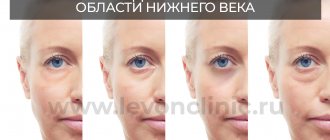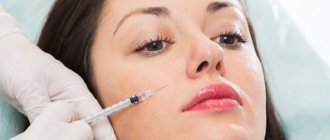People often confuse dark circles with bags under the eyes, mixing these fundamentally different problems into one.
Bags under the eyes are formed due to the redistribution of so-called fat bags (hernias). Sometimes bags are formed due to ptosis of the skin in the lower eyelid area (read more about the formation of bags under the eyes).
Dark circles (bruises) under the eyes, on the contrary, appear when there is a deficiency of fat in the eyelid area. The cause may be associated with genetic, pathological and age-related factors. In the latter case, the problem is combined - the person develops both bruises and bags under the eyes.
It is important to understand that there is not only one reason for the appearance of circles under the eyes - it is almost always a complex of reasons.
15% discount on the first visit for any procedure with any doctor!
Let's take a look at the anatomical structure of the eye area.
To understand the reason for the formation of circles, you need to imagine the structure of this area. Let's remember our school anatomy lessons.
Under the skin there is fat hidden - the so-called “fat packets of the face”. Below them are the orbicularis oculi muscles: they are responsible for squinting, squinting, blinking and other facial expressions.
Let's pay attention to the orbit of the eye and remember how many blood vessels and capillaries there are in this area.
It is very important to understand that blood vessels and muscle tissue are rather “dark” formations that are not very visible “on the face” only thanks to the skin and subcutaneous fat that cover these structures. Thus, skin and fat are the main concealers of dark circles under the eyes.
Thinning of the fat layer
The most common cause of dark circles. The skin of the lower eyelids is separated from the orbicularis oculi muscle and blood vessels by a thin layer of superficial fat.
With age, the superficial fat becomes thinner, “goes away,” and even through the thickest skin the orbicularis oculi muscle and blood vessels begin to show through. The muscle is dark red, the vessels are blue-scarlet.
The color of the circles depends on what is more visible - the blood vessels or the muscle. The color of dark circles has no connection with the kidneys, liver and other organs.
It happens that there is very little subcutaneous fat - this is a genetic feature. Then dark circles and semicircles can be seen from childhood.
Thin skin
The skin of the lower eyelids is the thinnest on the entire body. There is a thin layer of fat under the skin, but if there is little fat and the skin is thin, then the same vessels and muscles can be seen through the light. If your blood vessels are located close to the skin , and your skin is light, then it can show through even if there is fat!
Deep-set eyes
The lower eyelid is spatially located in the projection of the orbit of the skull. Anatomically deep-set eyes visually create a “retraction” of the skin relief in the area of the lower eyelid; when illuminated, a shadow part is formed in this area, which visually creates the effect of a dark circle.
To better understand this point, let's look at a visualization of another deficiency - the nasolacrimal trough depending on lighting.
Any age-related problem - be it a wrinkle, a bag, a hernia or bad skin - is noticeable thanks to only one thing: incident and reflected light.
The main essence of anti-aging aesthetic corrections is working with the distribution of light and shadow on our face. Any furrow, fold or bag is a play of light. Look at the illustrations to see how the visual appearance of the nasolacrimal trough varies depending on the direction of the lighting.
We all understand that both daytime natural and artificial light falls mainly on our face from above. It is this direction of lighting that most clearly emphasizes all the irregularities on the face!
It’s the same with deep-set eyes - the darkness of the lower eyelid depends to a greater extent on the lighting.
Dark circles from pigmented skin
Acquired and congenital pigment is the cause of the formation of dark circles in a normal anatomical structure. The peoples of the Caucasus region have a genetic predisposition to pigmented skin of the lower and upper eyelids.
Pigmentation can appear with age; usually such dark circles do not have a clear border at the bottom.
How to remove bruises after blepharoplasty?
It is within the patient's power to force tissue to regenerate faster. Therefore, proper care of the operated area is one of the key stages in the rehabilitation period. The first thing you need to do is follow all the doctor's instructions. To speed up the resorption of bruises, the doctor may prescribe treatment of the skin in the injured area with special preparations that ensure rapid resorption of the bruises. Remember that you cannot prescribe medications for yourself! Only the surgeon should prescribe what to apply to bruises after blepharoplasty.
The surgeon’s task is to select appropriate care products for the operated area, and the patient’s task is to follow all recommendations.
Applying cold, reducing the frequency of blinking and limiting computer work (as well as the use of other equipment, such as a TV or smartphone) will also help.
Hereditary causes of dark circles under the eyes
Heredity is a key player in the list of causes of dark circles under the eyes. But the concept of “heredity” itself is very broad.
Hereditary factors that provoke the formation of bruises under the eyes include:
- Specific facial anatomy (deep-set or slightly bulging eyes);
- Thin skin;
- Close location of blood vessels to the skin in the eyelid area;
- Constitutional features – excessively thin physique, in which there is a general deficiency of subcutaneous fat;
- Less commonly, chronic genetic diseases (for example, heart or liver).
Dark circles under the eyes associated with hereditary causes appear early - sometimes even in childhood. Indirectly, those bruises that arose in youth - before 20-25 years old (normally this does not happen) can be attributed to “heredity”. If parents develop dark circles at a young age, it is possible that the same fate will befall their child. And pathological “components” are not necessary for this.
Hereditary reasons can also include the properties of the skin : if the skin is thin, then the vascular network of the periorbital region “shines through” through it. This is usually the case for those with fair skin - dark circles can form as early as the age of 20, when fat packets begin to thin out.
It happens that hereditary factors are combined - a person has thin skin in the periorbital area and problems with blood circulation. The approach to such problems must also be comprehensive . Fortunately, in modern cosmetology there are fillers and other drugs that act at different levels: for example, the American MesoEyeC17 has a positive effect on the processes of blood and lymph microcirculation.
How to deal with hereditary causes?
As you understand, heredity can hardly be cured, so there is only one correction option - correcting the lower eyelid area with fillers (contour plastic methods). Even surgery won't change the situation much.
The cost of such a correction is from 15,000 rubles, the duration of the effect is up to 10-14 months.
Price for cheekbone correction with fillers
| Name | Price |
| Preparations: 1st group - Biorevitalizants | |
| Administration of the drug - MesoEye C71 /USA/ (1.0 ml) | 14 500₽ |
| Administration of the drug - NEAUVIA ORGANIC Hydro Delux XL /Italy/ (0.5 ml) | 5 000₽ |
| Administration of the drug - Hyalual 1.1% (1.0 ml) | 10 500₽ |
| Administration of the drug - Hyalual 1.1% (2.0 ml) | 13 900₽ |
| Preparations: 2nd group - Hyaluronic fillers | |
| Administration of the drug - Belotero Balance /Switzerland/ (1.0 ml) | 18 500₽ |
| Administration of the drug - Juvederm Volite /France/ (1.0 ml) | 19 000₽ |
Age-related changes and dark circles under the eyes
The most common cause of dark circles is age-related changes.
Age-related changes in the eyelids occur according to an approximate “schedule”:
- 20-25 years – appearance of “crow’s feet”;
- 25-30 years – formation of a mild nasolacrimal groove;
- 35-40 years – appearance of dark circles under the eyes;
- 40-45 years – formation of fatty bags (hernias) of the lower eyelid;
- 45-50 years – growth of hernias (bags under the eyes);
- 45-55 years and beyond - ptosis of the upper and lower eyelids.
It is impossible to fit every person into this scheme - for some, age-related changes in the eyelids begin earlier, for others later. But there is an obvious fact: if you ignore professional care from the age of 30, the regression will be more rapid, and radical interventions will become relevant closer to the age of 40.
So, the main reason for the age-related manifestation of dark circles is the thinning of the fat packet of the lower eyelid and the weakening of the ligamentous apparatus.
The orbicularis oculi muscle and ligaments stretch and sag with age. Moreover, with age, the size of the orbit increases, and the zygomatic bone flattens.
The situation is aggravated by age-related slowdown of metabolic processes and lymphatic drainage in this area.
Combating impaired lymphatic drainage and redistribution of subcutaneous fat with the help of creams and ointments is frankly naive.
Even the most expensive cosmetics are not able to “resolve” fatty bags and redistribute the tissue evenly to compensate for its deficiency in areas with dark circles under the eyes - this is obvious. A good cream only serves as an addition to full-fledged procedures in aesthetic medicine, but will never replace them.
Age-related dark circles under the eyes are also often caused by impaired blood supply, so they are soon naturally supplemented by bags and puffiness. The stagnant processes themselves do not add beauty to the skin - it acquires looseness and an earthy tint - pigmentation.
Bruises under the eyes due to illness, pigmentation.
Any pathological processes in the body have a bad effect on appearance. It is interesting that such aesthetic defects are the easiest to correct, but the problem is not solved at a global level. And a good cosmetologist (and a cosmetologist is a doctor) is obliged to warn the patient about this.
Increased skin pigmentation often occurs due to impaired functioning of melanocytes.
A simple example: due to liver disease, a patient develops so-called “liver spots”. “Suppressing” the activity of abnormally active melanocytes (cells that produce the pigment melanin) is an easy task for a cosmetologist. This can be done by the IPL method, vitamin meso-cocktails, additionally leveling the relief of the lower eyelid area with fillers. But will this make the liver healthier? No! This means that the problem will soon return, which will cause distrust in the cosmetologist and kill his authority in the eyes of a person. The same applies to heart, endocrine and other diseases.
Before dealing with external signs of illness, check and get your health in order. This will guarantee a successful and “long-lasting” facial transformation.
The list includes some of the diseases that cause dark circles under the eyes:
- Heart and kidney failure;
- Hypothyroidism;
- Adrenal dysfunction;
- Parasitic infestations;
- Cholelithiasis;
- Cholecystitis;
- Anemia;
- Vascular pathologies (circulatory disorders);
- Hepatitis and other liver diseases;
- Chronic intoxication;
- Hypovitaminosis.
Bruises under the eyes, caused by pathological processes in the body, usually do not appear spontaneously and are “chronic”.
Correction of the regime, rationalization of nutrition and other tricks are powerless against them. If you notice a similar problem along with specific symptoms, you should contact not only a cosmetologist, but also a therapist, and if you discover a disease, undergo appropriate treatment.
Rehabilitation
It is also important to follow a number of rules and prohibitions. For example, after surgery you should not sleep on your stomach with your face in the pillow. Sports activities and physical activity should be excluded. You are not allowed to visit the swimming pool, bathhouse or sauna. It is necessary to protect yourself from exposure to ultraviolet rays.
Of course, all these prohibitions apply only for the period of rehabilitation, and not for life. But nevertheless, observing the prohibitions is very important for a speedy recovery and elimination of bruises after blepharoplasty.
It is advisable to wear sunglasses at first. This stylish and, in addition, useful accessory, in addition to ultraviolet rays and bright lighting, will also protect your eyes from strong winds and dust particles.
Regime and dark circles under the eyes
In adults, bruises under the eyes sometimes appear due to the most banal reason - violation of the regime.
Overwork, lack of sleep, stress - all this makes the skin of the eyelids thin and dull, and the face pale and haggard. Metabolism is disrupted, the blood vessels of the eyelids appear more prominently, creating characteristic purple or bluish shadows under the eyes. A similar problem arises due to persistent dehydration, when a person constantly stays in rooms with dry air and drinks little water (as well as smokes and abuses alcohol).
A healthy lifestyle is the best friend of cosmetic procedures. In tandem it works flawlessly!
Try a double tactic: sleep 8 hours a day, eat right, spend time in the fresh air more often, and at the same time visit a competent cosmetologist. And you won’t give dark circles under your eyes a single chance.
A consultation with our specialists is the answer to your remaining questions.
Telephone consultation is always free!
Leave your contact, we will tell you everything and offer a discount!
Send
How long do bruises last after blepharoplasty?
Hematomas become most severe during the first two days after surgery. After this period, the bruises gradually decrease. The amount and duration of recovery for each patient is determined individually. Sometimes bruises are localized on one side of the face - left or right. This is absolutely normal, although it happens less often.
The weakest bruises last two to three days. The most severe hematomas can persist for up to two weeks. Such periods are completely normal, and there is no need to panic and wonder what to do with bruises after blepharoplasty. Simply listen to your doctor and carefully follow all instructions he gives you to ensure a great aesthetic result.










